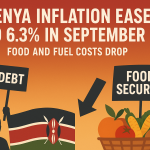Kenya’s inflation rate eased to 6.3% in September 2025, down from 6.8% the previous month, according to the Kenya National Bureau of Statistics (KNBS).
The decline is mainly attributed to lower food and fuel prices, providing a much-needed reprieve for households grappling with high living costs. Prices of maize flour, cooking oil, and vegetables all fell, helping stabilize the food index. Meanwhile, global oil prices retreated, easing transport and energy costs locally.
Economists say the easing inflation could allow the Central Bank of Kenya (CBK) to adopt a more accommodative monetary stance, potentially lowering interest rates to boost economic activity. However, they caution that external shocks, such as a spike in global crude oil or supply chain disruptions, could quickly reverse the trend.
The government has welcomed the decline, noting that stabilizing food and energy prices will improve purchasing power, spur consumer spending, and enhance economic growth momentum heading into 2026.
For ordinary Kenyans, the decline means reduced pressure on household budgets and improved affordability of essential goods.
📊 If the trend continues, inflation could return to the CBK’s preferred target range of 5% ± 2.5%, supporting long-term economic stability.








